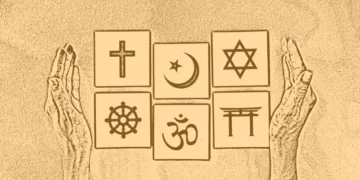If you are reading this, you have likely arrived from the article ‘What is Symbolic Interactionism?’. If you have not read that yet, I would recommend doing so before reading this one. Unless of course you are solely interested in an explanation of symbolic meaning.
In this article, I am going to explain about symbolic meaning. Unlike textbooks, I am going to take you on an interactive exploration of it by drawing you towards the actual process of how symbolic meaning works. Take a look at the symbol below. It is unlikely that most of you reading this article have ever seen this symbol before. I chose this symbol for that very reason as I want to make sure that you can experience the meaninglessness of it for a moment:

Right now, you probably have no awareness of what the symbol means. Think for a moment about that meaninglessness. How does it feel? It probably feels empty or confusing. You are probably wanting to be given meaning to help you interpret the symbol, to give you understanding. Hold on to that feeling of meaninglessness as I will refer back to this meaninglessness in a moment. First, I will tell you what the symbol actually means.
Attaching Symbolic Meaning
At the height of the Roman empire, the wearing of togas, a clothing made of woven wool and draped around the body, was common place. Bronze or copper clips were used to fasten the toga at the shoulder. Different togas represented different social positions. However, as in all societies, there were more secretive groups. Whilst the clips used to fasten togas were of no particular concern, one group used these clips to identify themselves with each other. The symbol above represented one such group who were employed as messengers to high-ranking Roman military. They would wear this symbol on the shoulder so that they could be identified by each other and by military forces as being messengers so that they would not be killed if discovered.
So, now I have explained this, you probably feel that you can now draw meaning from this symbol. It is a secret symbol. It is an identifier. It represents a job. You have now come to have a basic understanding of it even if you do not know the greater details of its history. Now, can you feel how that meaninglessness has gone and you now feel familiar with this symbol? I am sure the answer is ‘yes’. But wait! The story does not end there.
After the fall of the Roman empire, this same symbol was found in use 500 years later in Peru. It had changed from being a clip adorning the shoulder of a toga, to being a medallion worn around the neck. In Peru, the exact same symbol had come to be a kind of talisman which it was claimed protected one’s self from the wrath of the unscrupulous God Pachacamac.
How do feel now that you have learned this? Suddenly, you have gone from meaninglessness to meaning and now that meaning has been destabilised. You now have two interpretations of the symbol. Which one is the real meaning? How are we to draw meaning in this case? This is essentially the foundations of symbolic interactionism. It considers the way in which the individual draws subjective meaning from communications such as symbols, language, signs, or facial expression. So, if we take the example from above and apply the same principle to say hand gestures or other types of physical gestures, then we see the same phenomena. When we nod our heads, it tends to mean ‘yes’. If we shake our head, it tends to mean ‘no’. However, in Bulgaria it is the opposite – shaking the head means ‘yes’ and nodding means ‘no’. Which one is correct? We can only know through socially defined agreement.
We can look at this more technically. The symbol is an objective reality. It is concrete. However, the meaning given to it is subjective and abstract. This subjective and abstract meaning kind of exists separately from the symbol itself and becomes shared with others until we all come to agreement and accept its meaning. Language too works in this way. When we see a monkey, we call it a monkey because society has agreed on this abstract interpretation of the concrete object. As a side note, this same argument can also be found in Social Constructionism.
Meaninglessness
Returning to our symbol in the example, I regret to inform you that not only did I make the symbol myself but I completely made up both the stories behind it. I fabricated the whole thing. How do you feel now? That meaninglessness has returned yet the object remains. Perhaps now, the symbol is imbued with memories of how you were lied to and misled and has now come to represent that experience. This subjective response can be also shared with others. Perhaps you might tell a friend about this article and allow them to read it without telling them the outcome. Afterwards, when both of you discuss how you were duped by the meanings, you may come to share this symbolic meaning as being one of deception.
As a final point, think about how YOU could have done the same thing. YOU could have created a symbol and given it a meaning that you wanted to give it and attempted to garner social agreement to its meaning. This is what happens every day whether it’s through your own identity or perhaps corporate or media images that are shown to you. It is why the term ‘image is everything’ is used in the advertising world as the communication of symbolic meaning must be carefully controlled to transmit the desired messages.
Hopefully, you should now have experienced this short journey through symbolic meaning and have a clearer and more personalised experience of the concept of symbolic meaning.
External Reading
Blumer, H. (1969). Symbolic Interactionism: Perspective and Method. Berkeley: University of California Press.
Charon, J.M. and Cahill, S. (2004). Symbolic interactionism: an introduction, an interpretation, an integration. Upper Saddle River, N.J.: Pearson Prentice Hall.
Meltzer, B., Petras, J. and Reynolds, L. (2020). Symbolic Interactionism (RLE Social Theory). Routledge.











I’m a bit surprised that your explanation of symbolic interactionism doesn’t mention Erving Goffman’s foundational contributions to that approach nor even cite his work. I’m curious as to the basis for your choice.
FWIW, I’m not an acolyte of Goffman—I’m just a bit surprised because his contributions loom so large in the field.
This article is simply an everyday explanation of symbolic meaning to exemplify to people who are perhaps having difficulty understanding the concept. The ‘What is Symbolic Interactionism’ article covers the very basics. The point you pick up on would be an article in itself and will certainly be covered at some point.